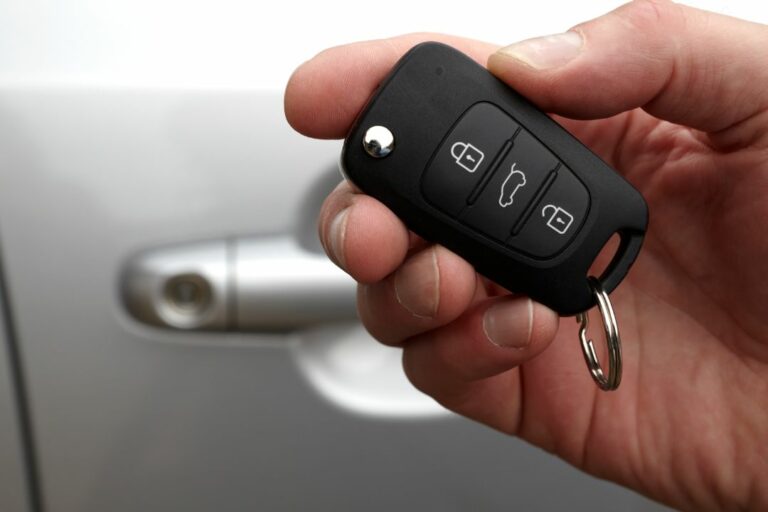How to Make Cigarette Lighter Turn Off With Car? (Simple Way!)

Are you tired of your car’s cigarette lighter draining your battery even after you’ve turned off the engine?
Or are you looking for a way to keep your dashcam powered without worrying about parasitic drain on your car’s battery? Look no further, because we’ve got some tips and tricks for you.
From rewiring the outlet to using a switch or fuse, there are several ways to ensure that the power to your cigarette lighter turns off with the car.
In this article How to Make Cigarette Lighter Turn Off With Car?, we’ll explore various solutions discussed in online forums and provide additional insights into powering dashcams while preventing battery drain.
So buckle up and let’s get started!
What is a Cigarette Lighter Outlet?
If you’re not familiar with what a cigarette lighter outlet is, it’s a small socket in your car that was originally designed for lighting cigarettes.
These days, however, it’s more commonly used as a power source for charging phones and other electronic devices while on the go.
The location of the outlet can vary depending on the make and model of your car, but it’s typically located on or near the dashboard panel.
It’s important to note that this outlet draws power from your car battery, which means leaving chargers or other accessories plugged in when the ignition is off could drain your battery over time.
Understanding the Power Flow:
Before we dive into the different methods to make your cigarette lighter outlet turn off with the car, it’s important to understand how power flows through this socket.
The cigarette lighter outlet is connected directly to your car’s battery and typically provides continuous power even when the ignition is turned off.
This means that any device plugged into the cigarette lighter socket will continue to draw power from the battery, potentially draining it over time.
To prevent this parasitic drain on your car’s battery, you will need to either manually unplug all devices or find a way to have the cigarette lighter outlet turn off with the car.
Different Ways to Make Cigarette Lighter Turn Off with Car:
If you want to turn off the power to your cigarette lighter when you turn off your car, there are several different methods you can try.
| Method | Description |
|---|---|
| Turn Off the Ignition | One of the simplest ways to turn off the cigarette lighter is to turn off the car’s ignition. When the car is not running, power to the cigarette lighter is cut off, deactivating it. |
| Unplug the Device | If a device, such as a phone charger or portable device, is plugged into the cigarette lighter socket, simply unplugging it will turn off the power to the socket and disable the lighter. |
| Use a Power Outlet Switch | Some vehicles have a dedicated power outlet switch that can be used to turn off power to the cigarette lighter socket. It may be located on the dashboard, center console, or near the socket itself. |
| Remove the Fuse | In some cars, the cigarette lighter is connected to a specific fuse in the fuse box. By locating the fuse responsible for the lighter and removing it, the power supply to the socket can be disconnected. |
| Use a Power Inverter with On/Off Switch | If a power inverter is being used to convert the car’s DC power to AC power, choosing a model with an on/off switch allows for easy control of the power supply to the inverter and the connected devices. |
| Install a Cigarette Lighter Disconnect | A cigarette lighter disconnect is a device that can be installed in the car’s electrical system. It provides a switch to easily turn on or off the power supply to the cigarette lighter socket. |
Method 1: Using an Add-a-Circuit Fuse Tap:
One way to make your cigarette lighter turn off with your car is to use an add-a-circuit fuse tap. This device allows you to add a new circuit without cutting into any existing wires in your car.
Simply plug the fuse tap into an existing slot in your fuse box and connect a new wire from the output side of the tap to your cigarette lighter socket.
Then, use a fuse with a lower rating than what’s already in the slot for added safety.
This will ensure that the power to your cigarette lighter socket turns off with your car, preventing any parasitic drain on your battery.
Method 2: Using a Voltage Regulator
If you’re not comfortable with messing around with your car’s wiring, another option to make the cigarette lighter turn off with the car is to use a voltage regulator.
A voltage regulator can help regulate the power output of your car’s electrical system and prevent overloading.
To use a voltage regulator, you’ll need to find the location of your car’s fuse panel and locate the fuse that controls the cigarette lighter outlet.
Once you’ve found it, remove the fuse and plug it into a powered slot on the voltage regulator.
Then, connect one end of a wire to any ground point in your car (such as a metal bolt) and attach the other end of that wire to one of the wires coming out of your voltage regulator.
Finally, connect another wire from the remaining wire on your voltage regulator directly into an ignition controlled socket (like an accessory port).
With this setup in place, when you turn off your car’s ignition switch or accessory switch after shutting down engine, all power will be cut off from both sources at once including cigarette lighter socket
By using this method instead of rewiring or switching out fuses can ensure safety precautions are taken without risking damage to vehicle’s electrical system.
Method 3: Using a Portable Car Jump Starter
If you’re looking for a simple and convenient solution to turn off the cigarette lighter socket when your car is turned off, using a portable car jump starter can be an effective method.
Simply plug the portable car jump starter into the cigarette lighter socket of your vehicle, and it will provide power to your devices while the engine is running.
When you turn off the ignition, the power supply from the jump starter will stop automatically, cutting off power to any devices connected to the cigarette lighter socket.
This method is particularly useful if you don’t want to mess around with wiring or fuses, as it’s simply a matter of plugging in and unplugging when needed.
Plus, having a portable car jump starter on hand can be beneficial in case of emergency situations where you need a quick boost for your battery.
Just make sure that you choose a reliable and high-quality portable car jump starter that won’t cause any damage or drain on your vehicle’s battery.
Check the user manual for instructions on how long it takes for automatic shut-off when there’s no longer enough load on those jumper terminals.
Method 4: Disconnecting the Battery
If you’re comfortable with disconnecting the battery of your vehicle, it’s also an option to turn off power to the cigarette lighter outlet. This method is straightforward, but it does have some downsides.
To disconnect the battery, first locate the battery location in your vehicle. Depending on your car make and model, this can be under the hood or in another location like under one of the seats or in the trunk.
Once you’ve located your battery, use a wrench or socket to loosen and remove both terminals from their corresponding posts.
Be careful not to touch any part of both terminals at once as this can lead to electrical shock.
While disconnecting the battery will effectively turn off power to all accessories connected directly to it, there are some downsides that come with using this method. For example:
- Disconnecting/reconnecting your battery may require resetting certain electronic settings on your car (such as clock time).
- If you leave something else plugged into one of those accessory outlets and forget about it while parked overnight for example;you’ll still end up having parasitic drains on other circuits including usually better hidden ones such as interior lighting which could slowly drain much more amperage than what would possibly simply keep phone charger running.
- You might need access codes for restarting infotainment systems etc
It’s important to weigh these factors against your specific needs before deciding if this method is right for turning off power to cigarette lighter outlet in your car.
Why You Need the Cigarette Lighter Outlet to Turn Off with the Car?
If you’ve ever left your phone charger plugged into the cigarette lighter socket overnight, you might have woken up to a dead battery in the morning.
That’s because even when the car is turned off, some accessory outlets can continue to supply power. This is called “parasitic drain” and can be a significant problem if it drains your battery too much.
To avoid this issue, it’s important that the cigarette lighter outlet turns off with the car. If not, any device connected to it will continue to draw power and can potentially drain your battery over time.
Additionally, having an always-on lighter socket could pose a safety risk as well since it leaves wires “hot” even when the engine is off.
So whether you’re concerned about preserving your car’s battery life or just want to minimize potential safety hazards, ensuring that your cigarette lighter outlet turns off with the ignition is essential.
More: Car Temperature Gauge Over Halfway (5 Issues 100% Fixed!)
Benefits of Turning Off Cigarette Lighter Outlet with Car:
Turning off the cigarette lighter outlet with your car’s ignition has a number of benefits, including preventing parasitic battery drain.
By cutting power to the socket when the ignition is turned off, you can avoid leaving devices like phone chargers plugged in and unintentionally draining your battery over time.
In addition to saving battery life, turning off the cigarette lighter outlet can also help prevent accidental fires from faulty chargers or other accessories.
Without power flowing to the socket when the car is turned off, there is no risk of sparking or overheating that could lead to a fire.
Plus, if you want to keep your dashcam running for longer periods of time without worrying about battery drain or memory card capacity, connecting it through an accessory switch would allow you complete control over its usage and monitoring.
Safety Precautions to Follow:
When attempting to make your cigarette lighter outlet turn off with your car, it’s important to follow some safety precautions to avoid damaging your vehicle’s electrical system or causing any accidents. Here are a few things to keep in mind:
- Always disconnect the battery before working on any electrical components or wiring in your car to avoid electrical shock.
- 2. When using an add-a-circuit fuse tap or voltage regulator, make sure to use the correct gauge of wire and fuse to prevent overloading or short circuits.
- 3. If you’re not comfortable with working on your car’s electrical system, consider consulting a professional mechanic or electrician for assistance.
- 4. Always use high-quality and reliable components when modifying your car’s electrical system to avoid potential hazards.
- By following these safety precautions, you can ensure that your modifications to the cigarette lighter outlet are done safely and effectively.
2mm Brake Pads Left (Should You Drive? How Far Can You Go?)
Conclusion:
In conclusion, there are several ways to make your cigarette lighter outlet turn off with your car, including using an add-a-circuit fuse tap, a voltage regulator, a portable car jump starter, or disconnecting the battery.
By cutting power to the socket when the ignition is turned off, you can avoid parasitic battery drain and potential safety hazards.
However, it’s important to follow safety precautions and carefully consider which method is right for your specific needs and vehicle.
With these tips and tricks, you can ensure that your car’s electrical system stays in good condition while keeping your devices powered on the go.






